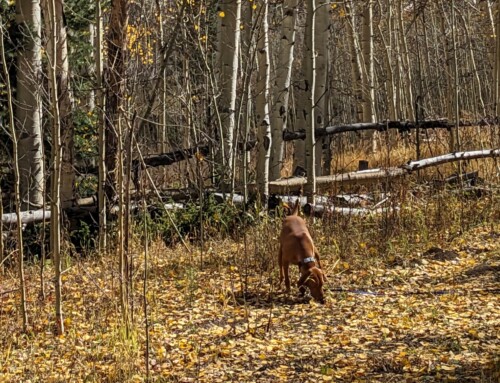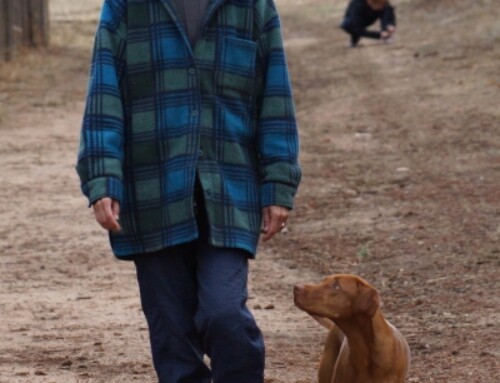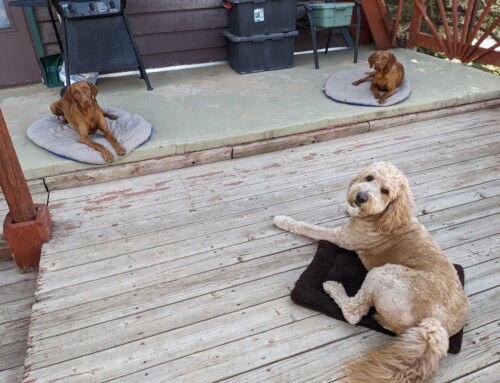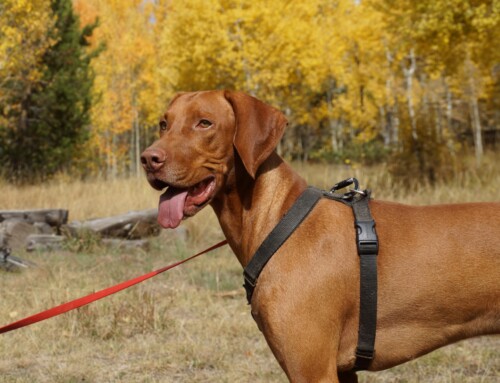DOG TRAINING OFFERED IN-PERSON AND ONLINEOur dog training services are delivered in almost any format that meets your needs. We have GROUP CLASSES at our indoor and outdoor facilities on our farm, ONLINE LIVE STREAMING classes, and SELF-PACED VIDEO-BASED training through our Online Dog Training Course. Our PRIVATE TRAININGS can be done in-home, outside, in public dog-friendly locations, at our facility on our farm, online via phone or video conferencing and through email. |
Question:
When I arrive home, my dog always jumps on me. I have tried pushing him down and telling him, “No!” and even turning my back and ignoring him, but he still jumps. How do I get him to stop jumping on me?
The Trainer Answers:
First, ask yourself, why does your dog jump on you? Most dogs jump on people for attention. Your dog is thrilled that you have come home and is eager to greet you! Most of us love an enthusiastic greeting – isn’t that one of the reasons we have a dog? He is always happy to see you whether you’ve been gone for six seconds or six hours.
Instead of asking how to stop your dog from jumping, complete this statement: “Rather than jumping, I would like my dog to ____________________.”
Rather than asking how to stop your dog from jumping, you should be asking yourself what you want your dog to do instead of jumping. You can stop him from jumping, but if you do not teach an alternative behavior, you might end up with a new and equally undesirable behavior, such as barking, pawing, or grabbing the leg of your pants.
If you have been giving your dog any form of attention when he jumps, you have been rewarding him for jumping and the behavior will continue. Attention might include: pushing him away from you, grabbing his paws, scolding him, or even simply making eye contact.
From now on, your dog should receive no attention for jumping. Be prepared – the behavior might get worse before it gets better. Be persistent about ignoring the jumping. However, do not just turn your back on him. Fold your arms, turn to the side and step slightly toward your dog, but do not speak to him or touch him with your hands. Stepping toward your dog allows you to take back the space your dog just invaded by jumping on you. If you step away, you allow him to control that space and he is more likely to keep moving toward you.
Wait for your dog to have all four feet on the ground, and then tell him what you want him to do. It doesn’t matter what it is, as long as you give him an alternative behavior to get your attention.
For example, if you want to greet and pet your dog, you might ask him for a sit. This is an incompatible behavior to jumping, meaning the dog cannot jump and sit at the same time.
If he is extremely energetic, you might consider asking for a more active alternative, such as retrieving a toy. He cannot jump on you if he is running to retrieve a toy from across the room. If you are using a retrieve, have toys ready by the doorway when you arrive home. Pick one up, and toss it just as your dog is coming toward you. Eventually, you will want him to run and find a toy himself, but this is a good start and provides an alternative to jumping.
Remember: if you train a new behavior and then do not reward it, the jumping will return. Continue to practice and reward the new behavior.
If you can, give your dog your alternative cue before he starts to jump. As he approaches you, ask for a sit or retrieve before his feet lift off the ground. If your dog jumps on other people, recruit friends, family or neighbors to help you in the same way. Have them ask for another behavior before he jumps on them. If he does jump, everyone should ignore the dog until he settles down.
If anyone gives your dog attention for jumping, he is being reinforced and will continue to jump. He might have stopped jumping on you, but he will continue to jump on others if someone else is reinforcing him for the behavior.
There might be times when you must keep your dog from jumping on someone. For example, an elderly person or a small child might be knocked down if your dog jumps up. In these cases, have your dog on leash before you open the door. Make sure he is at least a few feet back from the door so your visitor can safely enter. Give your dog just enough length of the leash to stand, sit or lie down where he is but not move around or jump. Stand on the remainder of the leash. If you are holding the leash in your hand, it still gives your dog the leverage to jump up. If you are standing on it, the leverage only allows your dog to move toward the ground not up in the air. Allow the visitor to approach only when your dog is calm. If he is not calm, then he will not have the opportunity to greet the visitor.
The most important things to remember are to be consistent and to always provide an alternative. Don’t make your dog guess what you want him to do. Help him do the right thing and you will both be much happier!
Our goal is to positively impact the lives of as many dogs and their families as we can, in part through our extensive library of video, infographics and text articles. 
|













